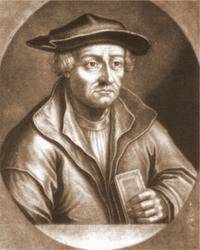Description Sebastian Münster
OverviewSebastian Münster
Sebastian Münster - cartographer, cosmographer, mathematician, Hebraist, doctor.
Born: 20 January 1488 in Ingelheim (now Germany).
Died: 26 May 1552 in Basel (now Switzerland).

Portrait of Münster, c. 1552.
Most important work:
1. Geographia Universalis (1540), a very important edition of Ptolemy (c. 87 – c. 150).
Ptolemy’s work was compiled in Alexandria, at the time of Rome’s greatest power. When the Roman empire fell, its wisdom vanished as well: The great libraries were destroyed, science was rejected and religion restored the old belief that the world was flat. From that time on, there is no evidence of any development in map making.
It wasn’t until the 1500s that times started to change. Ptolemy’s maps were rediscovered and studied by scholars. The invention of printing by Gutenberg made it possible to reprint old books and maps. And seafarers from England and Portugal needed maps.
Münster was of one of the first to reprint Geographia and thus started a new era in map making. Knowledge of geography changed dramatically as of the second half of the 16th century, which led to a gradual abandonment of Ptolemy, but map makers like Münster (together with Waldseemüller and Ortelius) were definitely crucial for the beginning of the Age of Discovery.
2. Cosmographia (1544), the oldest German description of the world.
This is a wood-printed book (not an atlas) and depicts not just maps of countries and cities, but for the first time also of each of the then known four continents, including the newly discovered Americas.
It presents very lively descriptions of the people, their habits and customs, the flora and fauna, and even the monsters (!) of the various countries. A number of famous artists, such as Hans Holbein the Younger, have contributed to this work.
The Cosmographia was one of the most widely read books of its time. It is re-printed several times, in six different languages, in a period of more than 80 years after the first edition.
Life:
The Münster family was catholic. Münster entered the Franciscan order when he was 17 and spent a number of years in a monastery. He finished his studies at Tübingen University.
In the late 1520’s Münster left the Franciscan order and joined the Lutherans. This allowed him to apply for an appointment at the prestigious University of Basel, one of the knowledge centers of printing technology in Europe. He started his work there as a Hebrew professor in 1529. He was the first to edit the Hebrew Bible, wrote various books on Hebrew grammar and composed a trilingual (Greek, Latin, Hebrew) dictionary. Probably because the job was not well paid, he dedicated much of his time to his other interests as well, notably map making.
His output as a cartographer was enormous and he enjoyed considerable fame during his life.
Münster was also a mathematician and a doctor.
He died of the plague, in Basel, at the age of 64.
Why do collectors love the maps of Sebastian Münster?
First of all: The maps are old (16th century) and represent the changing world (Renaissance, Age of Discoveries). It is fascinating to be able to witness the world through the pictures of that age.
Münster’s maps are often used as historical tools.
Others love them because they are printed on wood, the earliest technique of making prints and maps. It is a simple technique, giving a bold, black and white finish with little precision and sophistication. As the printing blocks were used for many years, the design lost its impact through the years and older prints are therefore often less crisp. That allows the collector to determine quite precisely the exact age of the map.
And if one likes pictures of sea monsters, dragons, cannibals, or interesting descriptions of regions and people, then Münster has a lot to offer.










